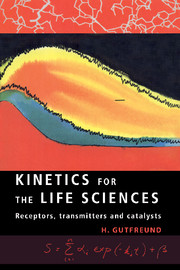Book contents
- Frontmatter
- Contents
- Preface
- 1 The time scales of nature: a historical survey
- 2 Some mathematical introductions
- 3 Elementary kinetic equations: ground rules
- 4 Kinetic analysis of complex reactions
- 5 Transient kinetics of enzyme reactions
- 6 Chemical relaxation phenomena
- 7 Factors affecting rates of reactions
- 8 The role of light in kinetic investigations
- References
- Index
8 - The role of light in kinetic investigations
Published online by Cambridge University Press: 08 January 2010
- Frontmatter
- Contents
- Preface
- 1 The time scales of nature: a historical survey
- 2 Some mathematical introductions
- 3 Elementary kinetic equations: ground rules
- 4 Kinetic analysis of complex reactions
- 5 Transient kinetics of enzyme reactions
- 6 Chemical relaxation phenomena
- 7 Factors affecting rates of reactions
- 8 The role of light in kinetic investigations
- References
- Index
Summary
Applications of photochemistry
Introduction and early applications
The heading of this section will conjure up a range of different expectations in terms of subject matter. In fact the whole chapter is more method oriented than the rest of this volume. It is necessarily, because of the range of the topics, more in the nature of a review of available tools and does not treat any of them in detail. None the less, the emphasis is on the kinetic problems which can be solved by the use of light to initiate and/or monitor reactions. It will be seen that the methods themselves present some interesting kinetic problems. In this area, as elsewhere (see section 1.1), classic physical investigations were rapidly applied to biological problems. Early studies of the fundamental properties of light were associated with experiments on vision by Thomas Young and on spectral changes during reactions of haemoglobin by Sir George Stokes, who also contributed to the discovery of fluorescence (see below).
Biological responses to light
A meaningful discussion of the role of light for sending and receiving signals as well as for an energy source in biological systems would cover several volumes. The photochemistry of photosynthesis, of the activation of plant enzymes, the initial reactions of rhodopsins involved in vision and bacterial energy transduction and the emission of light by photoproteins (see section 4.2) all present challenging kinetic problems. The kinetic events consequent on the photochemical reaction of the visual pigment are used in section 4.2 to illustrate kinetic modelling of sequential reactions.
- Type
- Chapter
- Information
- Kinetics for the Life SciencesReceptors, Transmitters and Catalysts, pp. 281 - 307Publisher: Cambridge University PressPrint publication year: 1995



